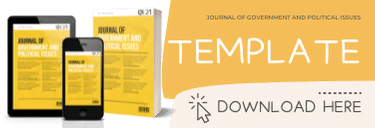Collaborative Governance and Hoax Politics in The Era of Covid-19 in Makassar City
DOI:
https://doi.org/10.53341/jgpi.v2i1.24Abstract
The spread of political hoaxes is quite massive and fast. As the coming political year approaches, inter-community friction may occur due to the spread of hoax news and can cause anxiety, hatred, and hostility in society. As a result, if it continues and is not controlled, it will result in conflicts between individuals and different groups. This study aims to find a Collaborative Governance model to prevent the spread of political hoaxes. This study uses a qualitative approach to reveal the forms and types of hoaxes on social media and reveal hidden values. The data collection method used focused observation techniques, in-depth interviews, and documentation. The results of the study show, namely: Frist, a political hoax is a form of Cyber Crime that seems simple easy to do but has a significant impact on people's social life. Second, types of political hoaxes, including, namely Satire or Parody, Misleading Content, Counterfeit Content, Fake Content, Wrong Connections, False content, and manipulated content. The strategy for dealing with political hoaxes is the movement to educate the public to be more critical in politics. The government must be supported by elements of education, independent state institutions, and other social institutions. The political literacy movement is a comprehensive effort that involves all parties and elements intensely and continuously in the fight against lies. Apart from values and norms, legal, social, and religious instruments must be included there. Political hoax must be considered a social disaster in the political space.
Downloads
References
Annur, C. M. (2020). Kominfo Temukan 3.801 Hoaks Selama 2019, Mayoritas Soal Politik. Retrieved January 1, 2022, from Kata Data website: https://katadata.co.id/desysetyowati/digital/5e9a4c3b50731/kominfo-temukan-3801-hoaks-selama-2019-mayoritas-soal-politik
Ansell, C., & Gash, A. (2008). Collaborative Governance in Theory and Practice. Journal of Public Administration Research and Theory, 18(4), 543–571. https://doi.org/10.1093/jopart/mum032
Assiroj, P., Meyliana, Hidayanto, A. N., Prabowo, H., & Warnars, H. L. H. S. (2018). Hoax News Detection on Social Media: A Survey. 2018 Indonesian Association for Pattern Recognition International Conference (INAPR), 186–191. https://doi.org/10.1109/INAPR.2018.8627053
Bennett, W. L., & Livingston, S. (2018). The Disinformation Order: Disruptive Communication and the Decline of Democratic Institutions. European Journal of Communication, 33(2), 122–139. https://doi.org/10.1177/0267323118760317
Firmansyah, R. (2017). Web Klarifikasi Berita untuk Meminimalisir Penyebaran Berita Hoax. Jurnal Informatika, 4(2), 230–235. https://doi.org/10.31294/ji.v4i2.2138
Hartaman, N., Wahyuni, W., Nasrullah, N., Has, Y., Hukmi, R. A., Hidayat, W., & Ikhsan, A. A. I. (2021). Strategi Pemerintah dalam Pengembangan Wisata Budaya dan Kearifan Lokal di Kabupaten Majene. Ganaya : Jurnal Ilmu Sosial Dan Humaniora, 4(2), 578–588. https://doi.org/10.37329/ganaya.v4i2.1334
Joo Chang, H. (2009). Collaborative Governance in Welfare Service Delivery: Focusing on Local Welfare System in Korea. International Review of Public Administration, 13(sup1), 75–90. https://doi.org/10.1080/12294659.2009.10805141
Juditha, C. (2018). Hoax Communication Interactivity in Social Media and Anticipation (Interaksi Komunikasi Hoax di Media Sosial serta Antisipasinya). Journal Pekommas, 3(1), 31. https://doi.org/10.30818/jpkm.2018.2030104
Khalyubi, W., & Perdana, A. (2021). Electoral Manipulation Informationally on Hoax Production in 2019 Presidential and Vice Presidential Election in Indonesia. Journal of Government and Political Issues, 1(2), 87–99. https://doi.org/10.53341/jgpi.v1i2.17
Kurniati, Munir, M., Hamidah, L., & Rizky, A. S. (2020). Monitoring dan Evaluasi Humas Pemerintah dalam Penggunaan Media Sosial untuk Memerangi Hoaks. Jurnal Manajemen Komunikasi, 5(1), 78–95. https://doi.org/10.24198/jmk.v5i1.27616
Kurniawati, Y. R. (2020). Pertanggung Jawaban Pidana atas Penyebaran Berita Bohong (Hoax) di Media Sosial. In Dinamika: Jurnal Ilmiah Ilmu Hukum (Vol. 26). Retrieved from http://www.riset.unisma.ac.id/index.php/jdh/article/view/5492
Miles, M. B., Huberman, A. M., & Saldaña, J. (2014). Qualitative Data Analysis (Edition 3). Los Angles: Arizona State University.
Na’im, M. A. (2017). HOAKS Sebagai Konstruksi Sosial Untuk Kepentingan Politik Praktis dalam Pilgub DKI Jakarta. Jurnal Darussalam: Jurnal Pendidikan, Komunikasi Dan Pemikiran Hukum Islam, 8(2), 361–370. https://doi.org/10.30739/darussalam.v8i2.107
Nurhajati, L., & Wijayanto, X. A. (2018). Framing Media Online Atas Pemberitaan Isu Politik Uang dalam Pilkada Serentak 2018. Jurnal Adhyasta Pemilu, 1(1), 43–52. https://doi.org/10.55108/jap.v1i1.4
Park, K., & Rim, H. (2020). “Click First!”: The Effects of Instant Activism Via a Hoax on Social Media. Social Media and Society, 6(2), 1–13. https://doi.org/10.1177/2056305120904706
Park, M. J., Kang, D., Rho, J. J., & Lee, D. H. (2016). Policy Role of Social Media in Developing Public Trust: Twitter Communication with Government Leaders. Public Management Review, 18(9), 1265–1288. https://doi.org/10.1080/14719037.2015.1066418
Pelani, H. (2019). Peran Komisi Penyiaran Indonesia Daerah Sulawesi Selatan dalam Menjaga Netralitas Televisi pada Pemilihan Gubernur dan Wakil Gubernur Tahun 2018. In CLAVIA: Journal of Law (Vol. 17). Retrieved from https://journal.unibos.ac.id/clavia/article/view/1216
Pemilu, J. A., Imawan, R. P., & Barat, J. (2020). Kerangka Evaluasi Pilkada : Evaluasi Pilkada Serentak Melalui Kerangka Integritas Pemilu. Jurnal Adhyasta Pemilu, 3(2), 159–182. https://doi.org/10.55108/jap.v3i2.16
Sabiruddin, S. (2019). Saring sebelum Sharing, Menangkal Berita Hoax, Radikalisme di Media Sosial. AL MUNIR : Jurnal Komunikasi Dan Penyiaran Islam, 2(1), 22–40. https://doi.org/10.15548/amj-kpi.v2i1.486
Safriani, A. (2021). Peranan Kepolisian dalam Mencegah dan Memeriksa Tindak Pidana Berita Palsu (Hoax) di Kota Makassar. Alauddin Law Development Journal, 3(3), 581–590. Retrieved from https://journal3.uin-alauddin.ac.id/index.php/aldev/article/view/15473
Saidah, M., & Rusfian, E. Z. (2020). Hoax management of presidential staff office: An example of government public relations strategies. Jurnal Studi Komunikasi (Indonesian Journal of Communications Studies), 4(1), 32–48. https://doi.org/10.25139/jsk.v4i1.1769
Septanto, H. (2018). Pengaruh Hoax dan Ujaran Kebencian Sebuah Cyber Crime dengan Teknologi Sederhana di Kehidupan Sosial Masyarakat. Kalbiscientia: Jurnal Sains Dan Teknologi, 5(2), 157–162. Retrieved from http://research.kalbis.ac.id/Research/Files/Article/Full/LCSCVZI11HG7VORWMAFRW7GH3.pdf
Downloads
Published
How to Cite
Issue
Section
License
Copyright (c) 2022 Rudi Hardi, Hardianto Hawing

This work is licensed under a Creative Commons Attribution 4.0 International License.
Authors retain copyright and grant the journal right of first publication with the work simultaneously licensed under an Attribution 4.0 International (CC BY 4.0) that allows others to share — copy and redistribute the material in any medium or format and adapt — remix, transform, and build upon the material for any purpose, even commercially with an acknowledgment of the work's authorship and initial publication in this journal.









